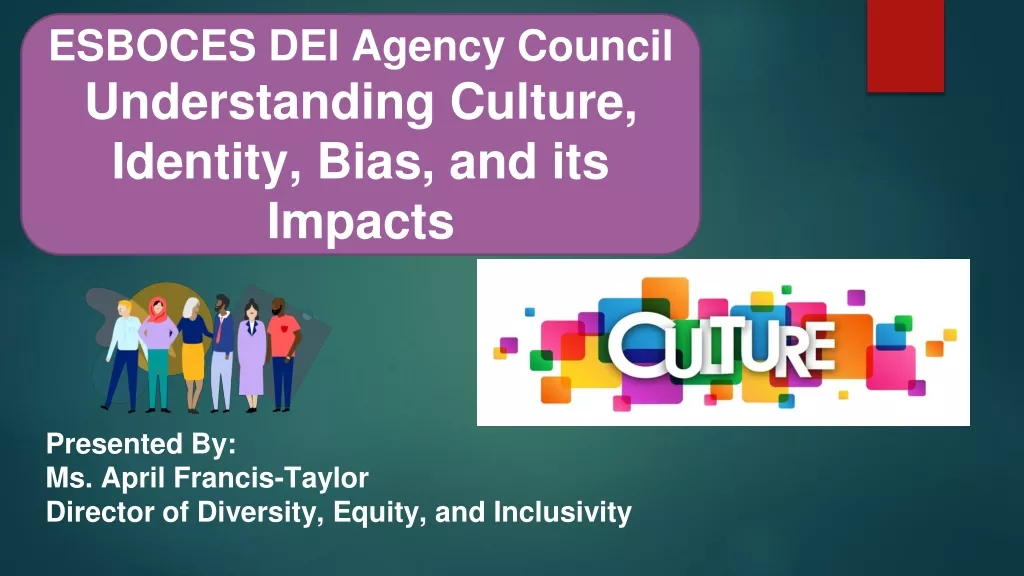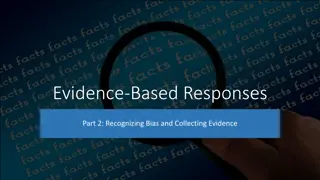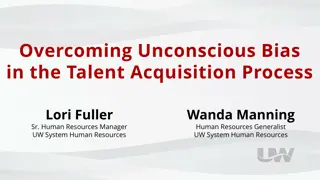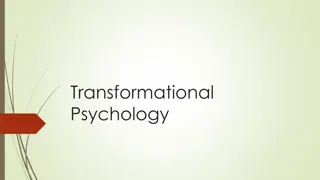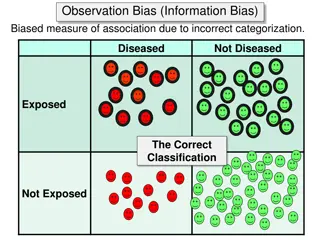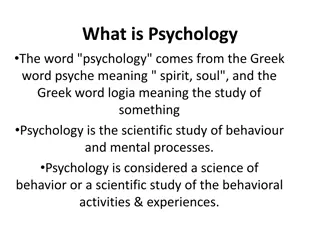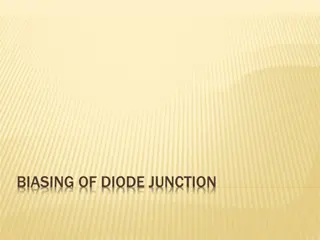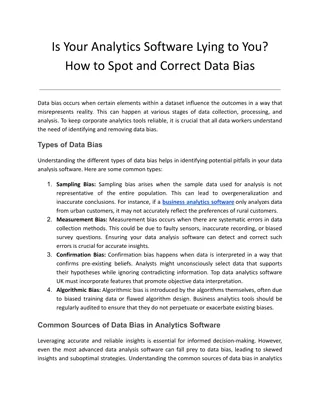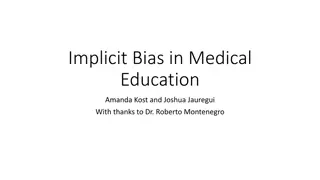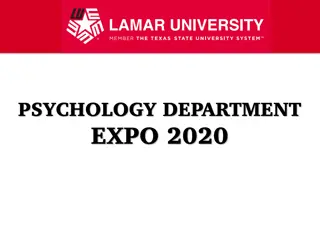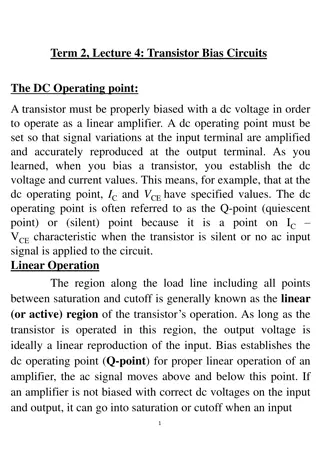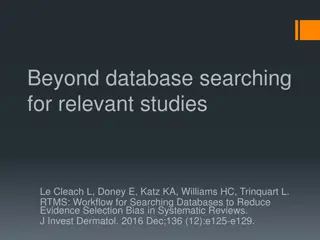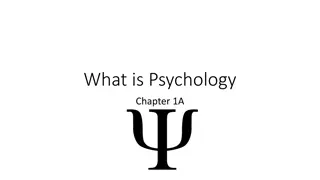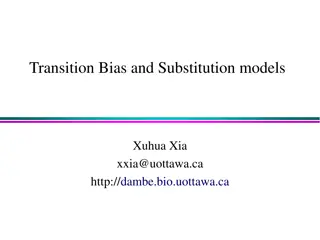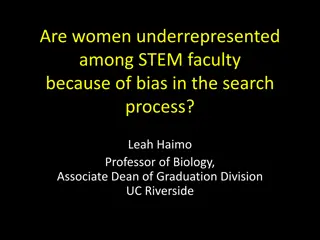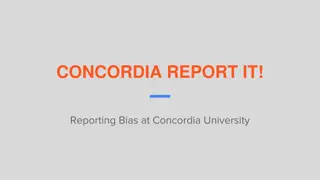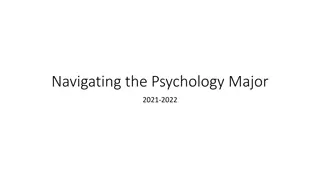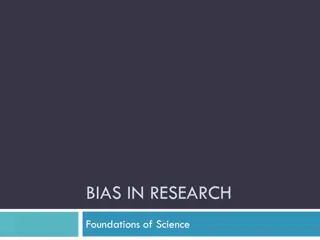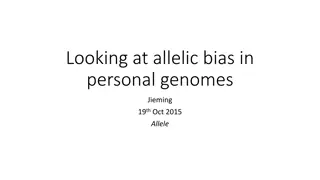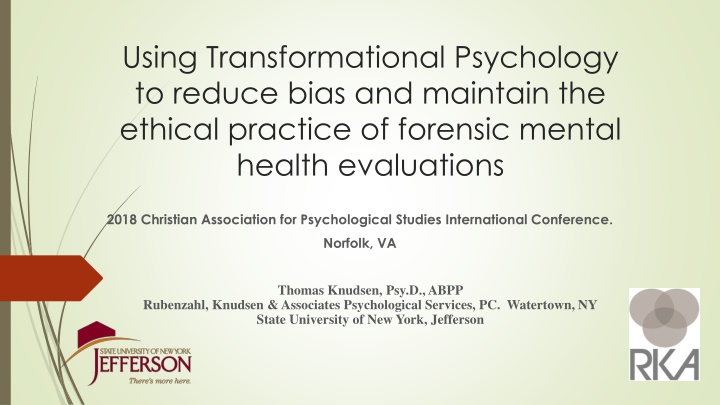
Unveiling Biases in Forensic Psychology Evaluations
Explore the impact of biases in forensic mental health evaluations and learn how transformational psychology can reduce bias and uphold ethical standards. Discover strategies to identify and address clinician biases, apply spiritual disciplines in assessments, and navigate critical psycholegal questions in the legal system.
Download Presentation

Please find below an Image/Link to download the presentation.
The content on the website is provided AS IS for your information and personal use only. It may not be sold, licensed, or shared on other websites without obtaining consent from the author. If you encounter any issues during the download, it is possible that the publisher has removed the file from their server.
You are allowed to download the files provided on this website for personal or commercial use, subject to the condition that they are used lawfully. All files are the property of their respective owners.
The content on the website is provided AS IS for your information and personal use only. It may not be sold, licensed, or shared on other websites without obtaining consent from the author.
E N D
Presentation Transcript
Using Transformational Psychology to reduce bias and maintain the ethical practice of forensic mental health evaluations 2018 Christian Association for Psychological Studies International Conference. Norfolk, VA Thomas Knudsen, Psy.D., ABPP Rubenzahl, Knudsen & Associates Psychological Services, PC. Watertown, NY State University of New York, Jefferson
Materials Online http://rkapsych.com/resources-2/training-material/Website: http://rkapsych.com/resources- 2/training-material/ http://rkapsych.com/resources-2/training-material/ Website: rkapsych.com -> Resources -> Training Material
Objectives Identify the types of clinician bias blind spot in forensic evaluations Explain basic components of ethical forensic mental health evaluations Apply the use of spiritual disciplines and mitigate bias in forensic mental health assessments.
Psycholegal Questions Criminal Court Competency Mental status at time of crime Not guilty by reason of insanity Threat assessment Family Court Parental Capacity Sex abuse validation Child Custody Best interest of the child Mental health condition/disability Malingering Civil Court
Forensic Psychology: Psychological Tools Used in Legal System Personality Functioning MMPI-2 MMPI-2RF PAI Risk HCR- 20/PCL-R STATIC-99R VRS/VRS:SO Assessment Malingering VIP TOMM
Forensic Psychology: Current Issues Disagreement Among Clinicians Guarnera & Murrie (2018) completed a meta-analysis that reviewed studies on determining adjudicative competency. They found that the clinicians agreed 15% - 30% of the time which can be translated to an interrater reliability coefficient between .30-.65. Murrie, Boccacini, Johnson & Janke (2008) found the differences in the PCL-R results were higher than the standard error of measurement reported by the measure. These differences are caused by the bias of the examining clinician.
Forensic Psychology: Current Issues Bias dilutes the science and utility of psychological sciences. Bias influence legal outcomes and create injustice for an individual. Forensic Clinicians have a The bias blind spot . (Neal & Brodsky, 2016; Zapf et al, 2018). Forensic clinicians falsely believe using introspection reduces their bias.
Forensic Psychology: Current Issues This paper will look at the nature and types of bias generally seen in forensic psychological practice and overview ways of bias mitigation proposed in the current literature. Forensic psychology can never divorce the practitioner from the equation. It is thus within the Transformational Psychological Model (Cole & Hall, 2010a) that the use of long-standing faith practices can offer additional resources for the Christian clinician to aid in mitigating bias. This model is hypothesized to decrease bias in the Christian clinician by using the principles of Charity and Contemplation from the Christian Tradition.
Bias in Forensic Psychology Bias with the forensic clinician can be defined as anything that skews the final conclusions due to irrelevant, contextual, or personal information. Bias can be implicit (unaware to the examiner) or explicit (aware to the examiner) (Neal & Grisso, 2014b). Bias is both an Ethical problem and a matter of Cognitive error.
Bias in Forensic Psychology Ethical Bias Ethical Bias is based on pre-conceived beliefs of the clinician (Guarrera, Murrie et al 2017). The APA (2013) Guidelines for the practice of forensic psychology states (2.07), Forensic practitioners recognize that their own cultures, attitudes, values, beliefs, opinions, or biases may affect their ability to practice in a competent and impartial manner. When such factors may diminish their ability to practice in a competent and impartial manner, forensic practitioners may take steps to correct or limit such effects, decline participation in the matter, or limit their participation in a manner that is consistent with professional obligations.
Bias in Forensic Psychology Ethical Bias Personal Attitudes Neal and Brodsky (2016) surveyed forensic clinicians concerning bias and found that preexisting personal, moral, and political values can influence their forensic opinions. Homant and Kennedy (1987) found that the personal attitude of the forensic clinician predicted whether the psychologist came to an opinion of not guilty by reason of insanity. Personality Traits. AK Miller and colleagues (2011) found that self-reported personality factors (agreeableness) affected the ratings used on the PCL-R.
Bias in Forensic Psychology Ethical Bias Lack of proper training. Neal and Grisso (2014a) surveyed a large international sample of forensic clinician about their practice. They reported that only 74% of those surveyed used at least one standardized assessment tool. Thus, the other 24% relied solely on clinical judgment. Those that used standardized assessment tools listed 286 different tools. NY CLS CPLR 3101 - installing the witness as an expert. Adversarial allegiance - the tendency of the forensic examiner to make a clinical judgment to the advantage of the party that retained them. The forensic examiner will side either explicitly (the hired gun) or implicitly (finding favor in the payor).
Bias in Forensic Psychology Cognitive Bias Cognitive heuristics are problem-solving short-cuts when limited information is available. The works of Amos Tversky and Daniel Kahneman (1974) built the Heuristics and Bias theory that explains three principle cognitive short cuts in human decision making: Representativeness, Availability, and Anchoring. Cognitive bias is more implicit in nature (Zapf et al, 2018).
Bias in Forensic Psychology Cognitive Bias The Representativeness heuristic - refers to a decision-making error occurring when evidence is overemphasis because it fits into the evaluator's preconceived prototype of the situation or person evaluated (Stahl, 2006; Neal & Grisso, 2014). Example: A forensic evaluator receives court documentation outlining erratic, moody, violent behavior by a mother in a custody case. The information appears to resemble someone with a borderline personality disorder. When the individual is being clinically evaluated, evidence of her emotional dysregulation is overemphasized because she fits the prototype often ascribed to individuals with BPD.
Bias in Forensic Psychology Cognitive Bias The Availability heuristic- refers to the decision-making error that happens when the evaluator overestimates the probability that an event can occur because prior incidents of the event are easy to recall. A clinician may assign a high-risk conclusion on a sexual offender being released on parole even though the statistical data says otherwise since there was a recent high-profile re-offense in the local community. Within the Availability Heuristic category is also the confirmation bias where the data that supports the clinician's hypothesis is overestimated without an equal weight on the data the contradicts the clinician's hypothesis.
Bias in Forensic Psychology Cognitive Bias Anchoring heuristic - the forensic evaluator is influenced by the initial information involved in the assessment. This is also called the primacy effect in forensic assessments. Example: The Anchoring Heuristic is often seen in custody evaluations where the information of the first parent interviewed is considered more valid than the second parent. In other types of forensic evaluations, the first set of background information or testing data unintentionally can weigh heavier in the mind of the forensic clinician.
Bias in Forensic Psychology Bias Mitigation: Proper training Ongoing continuing education within the field of forensic science and mental health evaluations. Forensic training tracks within academic programs. Trainings that raise awareness on implicit and explicit bias. Available postgraduate programs.
Bias in Forensic Psychology Bias Mitigation: Changing procedures Awareness Blind the forensic clinician from the referral party. This could minimize adversarial allegiance. Use the Null Hypothesis techniques (and other cognitive exercises). Look for evidence that would disprove your data, initial conclusion, etc. The clinician can use techniques that focus on their behaviors from the eyes of another.
Bias in Forensic Psychology Bias Mitigation: Changing the clinician At the center of the bias dilemma is the forensic clinician. Introspection does not work However, the clinician is able to observe his or her forensic assessment behavior, choices, and techniques as through another s eyes can help in seeing bias. Christian clinicians have resources from within their faith that can also aid in mitigating bias in forensic evaluations.
Transformational Psychology Coe & Hall, 2010 Transformational Psychology claims that the personal, spiritual, ethical, and experiential matters have a system of its own epistemology and deemed real to the Christian. These things that are real to the Christian can be studied with the same validity as objectivity. The Christian believes things because there has been an experience within reality from his or her faith. The Christian psychologist recognizes these two forms of knowing reality and can work together in blending them. In fact, the Transformational Model uses the term Working from behind the veil as a keystone for the utility of this model. As the Christian Psychologist is able to see the real world that is created by God, he or she can remove the obstacles that come from over dependences on the paradigms within the science of psychology. One of the specific components of Transformational Psychology s integration is the interplay between the clinician doing the science and the science itself. The emotional-spiritual development of the clinician is necessary to gain access to the full spectrum of truth. Coe and Hall (2010a, 2010b) call this Doing psychology in the Spirit.
Bias Mitigation: The Disciplines of Charity and Contemplation The Transformational modal sets the foundation for integrating techniques from within the Christian tradition. These techniques are viewed from within the Christian Tradition as a method for cultivating insight, clarity, and personal honesty. The techniques reviewed here will focus on spiritual disciplines as discussed by several theologians within the last 100 years Thus, their writings are perhaps influenced by historic psychological theories. In this sense, the integrative process has already occurred, at least implicitly, by these authors The Christian disciplines of Contemplation and Charity (the practice of Christ-love) can override the problems with introspection and allow for self- reflection beyond introspection and see self as through another.
Bias Mitigation: The Disciplines of Charity It is a truism from within the Christian tradition to love another. Behaving and thinking in a loving manner has been debated. The true answer, which is supernatural, tells us that we must love ourselves in order to be able to love others, that we must find ourselves by giving ourselves to them. The words of Christ are clear: Thou shalt love thy neighbor as thyself. This is not merely a helpful suggestion, it is the fundamental law of human existence. (Merton, p.xix).
Bias Mitigation: The Disciplines of Charity Charity is a dynamic process. There has be genuine self-love. Genuine self-love is awareness and acceptance of being a child of God, created in his image. Christian charity is the manifestation of the image of God. It is the person s love of the image of God within that allows for the love of others regardless of the person. There must be recognition of the image of God in the person being loved Loving in this manner requires work by the individual clinician to be able to tear down the inner obstacles, false images, insecurities, etc. to be able to truly see the reality of the image of God (Bisson, 2017).
Bias Mitigation: The Disciplines of Charity Merton (1958) explains : We can come to understand others only by loving Him who understands them from within the depths of their own being. Otherwise we know them only by the surmises that are formed within the mirror of our own soul. If we are angry, we will think them always angry. If we are afraid, we will think them alternately cowardly or cruel. If we are carnal, we will find our own carnality conveniently reflected in everyone who attracts us in doing this we do not come to know them as they are: we only deform them so that we may know them as they are not.
Bias Mitigation: The Discipline of Contemplation Three ways of Seeing of the monks of St. Victor The first eye was that of the flesh. It used thought and sight The second eye was of reason The third eye was that of true understanding, also called contemplation
Bias Mitigation: The Discipline of Contemplation The contemplative way of seeing is being present with the self and reality with Christ like love. It is seeing the way God sees. Contemplative seeing is seeing Christ in the eyes of those being evaluating. The manifestation of the event of the Cross is the defining point for all within the Christian tradition. As the Christian forensic clinician demonstrates contemplative love, This way of seeing allows the true image of God of the person to be realized and loved. When this dynamic occurs, the event of the Cross is re-lived.
Bias Mitigation: The Discipline of Contemplation Contemplative seeing is with detachment, indifference, emptiness. The desert fathers and the continued monastic way of life worked on developing a way of seeing the world, called apatheia, that was indifference and detached in order to produce clarity. With detachment, the person no longer needs to mold the observations into a preconceived world. It is complete acceptance from what is presented. Detachment does not allow the emotions to cloud, judge, or conform what is being seen in order to fit into the ego s needs for security.
Bias Mitigation: The Discipline of Contemplation The contemplative way of seeing is through brokenness. A second type of seeing is called penthos. This seems to be a nature reaction to apatheia. This allows us to see our world and the people before us with indifference and detachment. We will see the otherness in them, without our projections or transference. When the love of Christ happens, our truly seeing will change us by the true otherness. We will become impacted by what we see through the lens of the eyes of Christ.
Bias Mitigation: The Discipline of Contemplation Henri Nouwen wrote (1985). We can see that in order to be of service to others we have to die to them; that is, we have to give up measuring our value with the yardstick of others. To die to our neighbors means to stop judging them, to stop evaluating them, and thus to become free to be compassionate. Compassion can never coexist with judgment because judgment creates the distance, the distinction, which prevents us from really being with the other.
Forensic Bias: Conclusion and future study The spiritual disciplines of charity and contemplation allow the clinician to do the forensic work by seeing the full spectrum of reality as God created. It will remain necessary to include the use of all methods for reducing bias. Christian forensic clinicians can build on this perspective as a way of doing his or her work in the spirit integrating the Christian Tradition with the difficult tasks of forensic mental health assessment. This is something more, something genuine and divine that allows us to see reality as it is without our propensity to manipulate it with our heuristics, bias, and sin. It allows us to see ourselves and bias more clearly using methods that are known to be true from the reality of the transformed psychologist.
Forensic Bias: Conclusion and future study There is a rising body of literature in the use of mindfulness as a manner to foster self-care and improve overall clinical practice (Boellinghaus, Jones & Hutton, 2013). Mindfulness uses a style of contemplation as a nonjudgmental self- awareness within each moment (Kabat-Zinn, 1994). It is based from ideas within the Buddhist tradition. There is a potential crossover in the area of mindfulness research. Perhaps future studies into this idea of bias mitigation could provide key constructs that can link the practice of general mindfulness and the contemplative life.
Forensic Bias: Conclusion and future study Cultivating a contemplative life in programs that emphasize spirituality with psychological training. The use of mindfulness in maintaining the humanness in the assessment of adjudicates. Psychological training can emphasize the ethical component of self- awareness as a matter of self-care for forensic clinicians.

